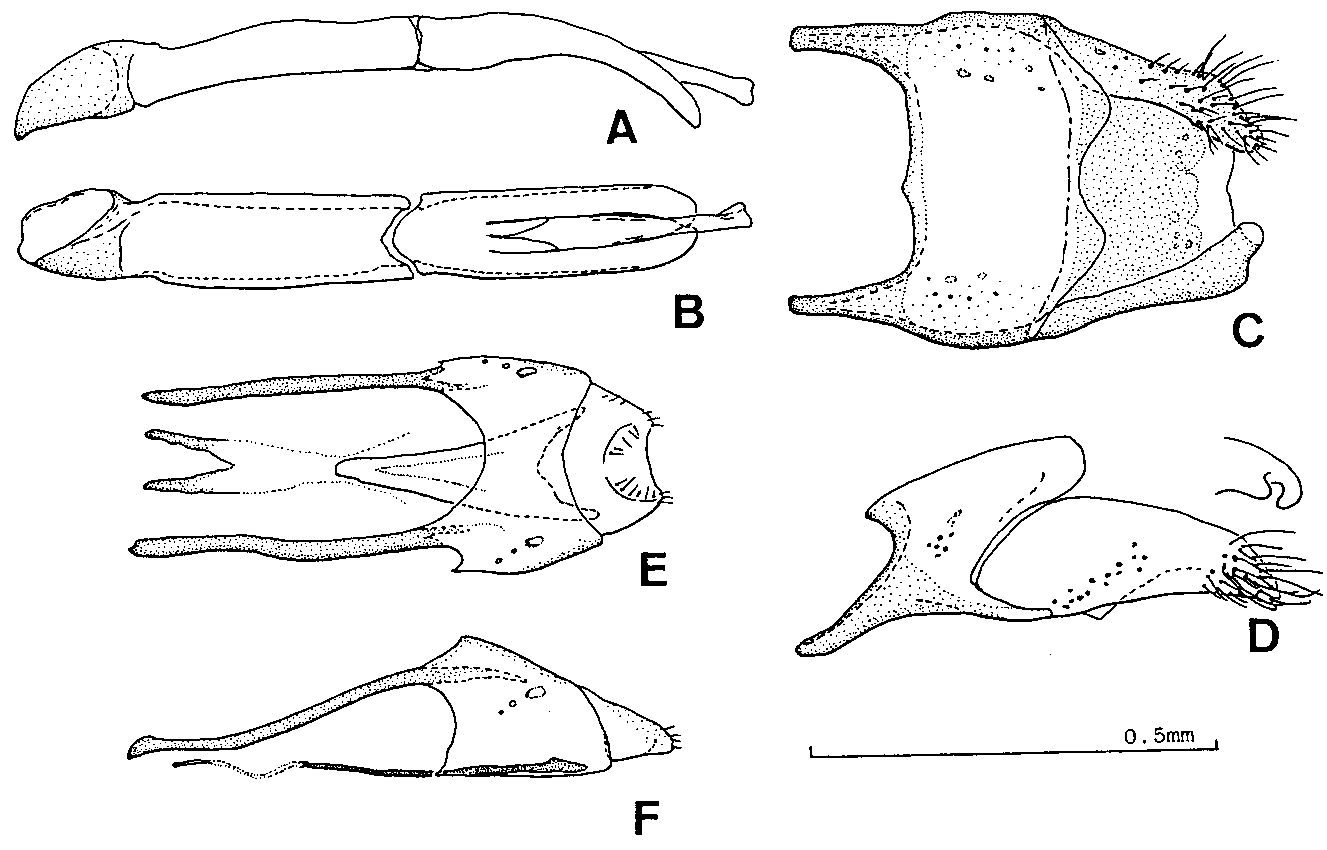Niponius impressicollis Lewis, 1885
Niponius impressicollis: Ohara, 1994, 68.
Nioponius impressicolis Lewis, 1885b: 333 [Japan, Yuyama, in Higo to
Junsai in Yezo (= Kyûshû to Hokkaidô)]; Gardner, 1926:
2; Reichardt, 1929b: 274, 273; Gardner, 1935: 5; Reichardt, 1941: 69; Nakane,
1963: 67, pl. 34, fig. 3; Kryzhanovskij and Reichardt, 1976: 77 [key, description];
Hisamatsu, 1985: 219, pl. 40, fig. 3.
Japanese name: Hoso-emma-mushi.
Original description. "Cylindricus, sat elongatus,
robustus, niger, punctatus. Antennis pedibusque, nigro-piceis, clava tarsisque
rufis; epistomo cornuto, piceo, transversim bicarinato, thorace grosse punctato,
utrinque profunde impresso. Elytris striis 1 validis et caeteris punctiformibus
vel obsoletis. Propygidio quadri foveolate. Pygidio profunde bisulcato.
Long. 5 - 5.1/2 mm."
Ohara (1994)
Description. Biometric data are given in Table 7. Body cylindrical, moderately
stout. Cuticle shining, black; tarsi, antennae and projection of epistoma
dark rufopiceous.
Projection of epistoma (Fig. 43A, C) moderately stout and long, its apex
strongly carinate and dorsal surface with two or three transverse carinae.
Head densely with transverse rugae on apical third; median third of the
surface sparsely covered with moderate punctures, the punctures separated
by two to five times their diameter, with other fine punctures intermingled;
basal third finely and sparsely punctate; depression on mid line deeply
present on apical half.
Pronotum completely with marginal stria on lateral side, the stria strongly
carinate; surface with an excavation (Fig. 43D, E) on each mediolateral
side, and sparsely covered with large, round and deep punctures which are
irregularly scattered, and with other fine punctures sparsely intermingled
among the large ones.
Epipleura of elytra completely with marginal elytral stria, which is
carinate and of which the apical end attains to the apical fifth; area between
epipleural margin and elytral marginal stria impunctate and extremely finely
strigate. First dorsal stria present on basal fourth and strongly carinate,
its basal end deeply excavate. Second to 5th dorsal striae almost obsolete,
being represented by rows of coarse punctures. Sutural stria strongly impressed
and represented by a row of longitudinal coarse punctures on basal two-thirds.
Surface of elytra somewhat convex on humeral area, and deeply and transversely
excavated near the basal margin; represented by rows of coarse punctures;
intervals among the rows sparsely clothed with fine punctures on basal half,
and densely on apical half, the punctures becoming coarser on apical third,
and in lateral area these punctures somewhat much denser.
Propygidium (Fig. 43G) with four large, round, shallow and transversely
placed foveae which become shallower posteriorly; surface sparsely covered
with coarse punctures, which are as coarse as elytral ones, and other fine
punctures densely intermingled among the coarse ones. Pygidium (Fig. 43G)
with a large, round, and somewhat deep fovea behind each basal corner; inside
of the fovea sparsely and moderately punctate; surface coarsely punctate
on median area, the punctures separated by three to four times their diameter
and becoming finer anteriorly, and other fine punctures sparsely intermingled
among coarse ones, the fine ones becoming denser apically and laterally.
Antennal grooves (Fig. 43B) deep under eyes. Mid line of underside of
head deeply excavate, its basal end beyond transverse line. Surface of underside
of head shining, sparsely and finely punctate on apical half, and evenly
clothed with fine punctures which are separated by two to three times their
diameter on basal half.
Table 7. Biometric data of Niponius impressicollis Lewis.
-------------------------------------------------------------------
HOW 0.57-0.70 (0.65±0.021) 5
HW 1.09-1.25 (1.19±0.026) 5
PW 1.30-1.56 (1.46±0.042) 5
PL 1.27-1.66 (1.51±0.067) 5
EL 1.61-1.93 (1.77±0.061) 5
EW 1.40-1.66 (1.54±0.051) 5
ProW 0.83-0.94 (0.88±0.021) 5
ProL 0.57-0.42 (0.48±0.028) 4
PyL 0.73-0.57 (0.64±0.023) 5
PTL 1.01-0.88 (0.96±0.025) 4
MSTL 0.83-0.78 (0.79±0.011) 4
MTTL 0.96-0.78 (0.88±0.033) 4
---------------------------------------------------------------------
Prosternal lobe (Fig. 43F) transverse and narrow, its anterior margin
densely with hair. Prosternal keel completely with two carinal striae, of
which the basal ends are united with each other in an arch; surface of keel
evenly punctate as basal half of head.
Mesosternum longitudinally and shallowly sulcate on median third; lateral
third evenly punctate as basal half of head and extremely finely strigate;
sometimes lateral marginal stria present on basal half at each anterior
corner. Meso-metasternal suture well impressed and complete. Metasternum
longitudinally and shallowly sulcate on mid line; lateral metasternal striae
strongly carinate and divergent posteriorly. Intercoxal disk of metasternum
sparsely and coarsely punctate, the punctures twice as coarse as mesosternal
punctures, and other fine ones sparsely intermingled among them. Lateral
disk sparsely covered with large punctures, the punctures becoming finer
apically.
Intercoxal disk of 1st abdominal sternum deeply striate on basal three-fourths
on each lateral side, and punctate as intercoxal disk of metasternum, but
the punctation is much denser.
Protibia slender and with two denticles on outer margin.
Male genitalia as shown in Fig. 44.

Remarks. Niponius impressicollis is the largest species of the genus
in Japan. It can easily be recognized by its size and the presence of excavations
on the pronotum.
This species is found from the galleries of a scolid beetle, Hylesinus
striatus Egg. on ash, Fraxinus mandchuria (Kryzhanovskij and Reichardt,
1976).
Ohara (1994)
[Honshû] <Fukushima-ken> 2 exs., Yunohana, Tateiwa V. Minami-Aizu,
19/vi/1947, Y. Kurosawa leg.; 4 exs., Onozawa, Egawa, Minami-Aizu, 17/vi/1950,
Y. Kurosawa leg. (NSMT). <Mie-ken> 2 exs., Mimune, 18-21/vi/1955,
H. Ôhira leg. <Hiroshima-ken> 2ÅâÅâ,
Sandankyô, Aki, 7-8/viii/1966, S. Ôsawa leg.
Specimens examined [additional records]. (Ohara, 1999a).
[Honsho] Fukushima-ken: Douzan (1 ex., 2/viii/1972), K. Tazoe. Gumma-ken:
Yunogoya-rindô, Minakami (1 ex., 7/viii/1988), K. Akiyama. Kanagawa-ken:
Sagami-Oyama, alt. 900-1200 m (1 ex., 15/vi/1994), K. Kawada.
Distribution. Japan (Hokkaido, Honshu, Shikoku,
Kyushu); Taiwan; Ussuriyskij Kray.

Emmamushi.Home/Niponiinae/Niponius/References


